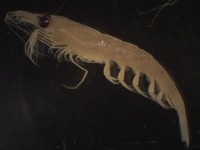
(Photo: Huntsman Marine Science Centre)
Nordic Krill
Meganyctiphanes norvegica
Krill resemble shrimp, have a solid exoskeleton, and are transparent. These krill have large red eyes, long antennae, and five pairs of swimming legs. Eggs and nauplii are 0.5 millimetres. Krill adults are 22 to 45 millimetres in length.
Authority
Sars, 1857
Classification Details
Phylum: Arthropoda (arthropods); Subphylum: Crustacea (crustaceans); Family: Euphausiidae (krill)
Habitat
Found in the Atlantic Ocean and the Mediterranean Sea. On northwest Atlantic coasts, they range from the Arctic to Cape Hatteras at a depth of 100 to 499 metres. Both the adults and larvae are zooplankton, swimming in the water column. They undertake daily vertical migrations, spending the daytime deeper than at night. They are sensitive to disturbance.
Diet
Feed on small zooplankton and sometimes algae, using their mouthparts to draw food into the mouth.
Reproduction
Sexes are separate. During the spring, females lay 350 to 550 eggs. They molt between mating events and each egg clutch. The life stages include: egg, nauplius, metanauplius, calytopis, and furcillia. It takes larvae approximately one year to go through all moults to become adults. Life expectancy is likely one to two years.
Fun Facts
This species is an important component of the zooplankton and provides food for whales, fish, and birds. It sometimes forms red swarms at the sea surface that attract abundant aerial and aquatic predators. Densities in these swarms can be as much as 770 000 krill (or 154 kilograms) per cubic metre of seawater.
References
van Couwelaar M (2003) Zooplankton and micronekton of the North Sea http://species-identification.org/species.php?species_group=zmns&id=449&menuentry=soorten Accessed online 22 January 2020. Nicol S (1984) Population structure of daytime surface swarms of the euphausiid Meganyctiphanes norvegica in the Bay of Fundy. Marine Ecology Progress Series 18, 241–251. Nicol S (1986). Shape, size and density of daytime surface swarms of the euphausiid Meganyctiphanes norvegica in the Bay of Fundy. Journal of Plankton Research 8, 29–39. Pinchuk A and Hopcroft R (2010) Arctic Ocean Diversity. Meganyctiphanes norvegica. http://www.arcodiv.org/watercolumn/euphausiid/Meganyctiphanes_norvegica.html Accessed online 22 January 2020. Siegel V (2020) World Euphausiacea Database. Meganyctiphanes norvegica (M. Sars, 1857). Accessed through: World Register of Marine Species at: http://www.marinespecies.org/aphia.php?p=taxdetails&id=110690 Accessed online 22 January 2020.

